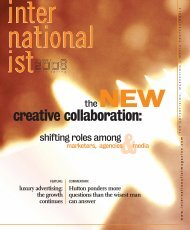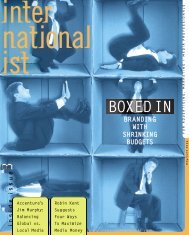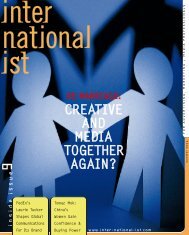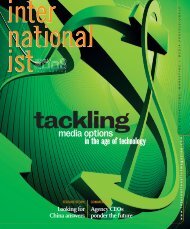4 - Internationalist
4 - Internationalist
4 - Internationalist
You also want an ePaper? Increase the reach of your titles
YUMPU automatically turns print PDFs into web optimized ePapers that Google loves.
Sprite brand. Subscribers can share photos and<br />
download content. The service kicked off in China in<br />
June, followed by the United States. Car maker<br />
Toyota was the first car manufacturer to market its<br />
brand on the Second Life virtual world Web site.<br />
Second Life citizens could customize Toyota’s Scion<br />
model, which the company would re-create for customers<br />
in real life. To reach under 18-year-olds, who<br />
are not allowed to subscribe to Second Life, Toyota also<br />
marketed the Scion in Whyville, the educational virtual<br />
world for kids, in case they could influence parents to<br />
buy the car. Seattle-based Soda Jones invites consumers<br />
to create their own labels for the beverage’s<br />
bottle and reproduces them for actual sales. The company’s<br />
Web site features a message board on which<br />
several of the consumers are griping about the lengthy<br />
period of time it takes for Soda Jones to bring out their<br />
labels. During the 2007 TV coverage of the Super<br />
Bowl, beer maker Anheuser-Busch featured its TV spot<br />
on its own Internet channel bud.tv, and invited viewers<br />
to vote for their favorite AB commercial by text or<br />
email. PepsiCo also worked with consumers in a<br />
competition to produce a Super Bowl commercial for<br />
the company’s Doritos chips. Finalists were invited to<br />
watch the Super Bowl at a special party, where the winner<br />
was announced. The winning entries were transmitted<br />
online (www.crashthesuperbowl.com). These<br />
consumer-focused campaigns are the exceptions, and<br />
not the rule. Even a global brand owner such as Max<br />
Mara, the secretive luxury women’s wear retail chain,<br />
is launching its first Web site in 2008. However, the<br />
shift addresses Max Mara’s need to give its customers,<br />
including younger consumers, greater access to the<br />
company’s brands, such as Marina Rinaldi, Sportmax,<br />
and Max & Co. When targeting a business customer,<br />
copier giant Xerox has proven that reaching the consumer<br />
directly can benefit business growth. In an<br />
award-winning 2006 pan-European campaign, the<br />
company renowned for its black-and-white copiers set<br />
out to highlight the improved experience of using its<br />
color products. It did so by inserting brightly colored<br />
brand messages directly in the black-and-white<br />
business editorial pages of leading national newspapers<br />
read by existing and potential customers. Xerox calls<br />
the strategy “active engagement.” These marketing<br />
activities illustrate that marketers take consumers<br />
for granted consumers at their peril. In fact, the more<br />
they engage consumers directly, the more goodwill they<br />
win, encouraging the consumer to promote the brand<br />
by word of mouth or, in the digital age, “wordofmouse,”<br />
says Steve Garton, at Synovate, the market-research<br />
unit of global communications group Aegis. For<br />
Daniela Krautsack, Vienna-based managing director<br />
of Magic Moments, a MediaCom subsidiary, the future<br />
should see marketers use consumer and environmentally<br />
friend technology to give users a greater say in<br />
campaigns. An expert in ambient media, Krautsack<br />
talks about RFID-activated billboards that communicate<br />
directly with the consumer; flexible TV screens;<br />
and consumer-controlled clothes that glow with marketer’s<br />
messages. As she says: “Some people might<br />
not call it ambient. They may prefer to call it ‘branded<br />
utility’ or ‘empathy space.’ The point is they will be used<br />
when the consumers are carrying out their hobbies or<br />
travelling, not when they are static; that is when you<br />
reach these new consumers.” Among future consumer-friendly<br />
media technology that she asks us to<br />
watch out for:<br />
OLED (organic light-emitting diodes) — although still<br />
at the R&D stage, it is considered environmentally<br />
friendly and is expected to replace flat LCD (liquid<br />
crystal displays) on existing TV sets. In addition, the<br />
material created from it can be moulded into flexible<br />
objects. (Sony Corp. is the first company to have<br />
announced plans to launch an OLED TV set, with a<br />
screen that is so thin, it rotates on a swivel arm without<br />
snapping, and is due out Japan in December<br />
2007).<br />
Lumalive — invented by Philips, it is a fabric-type of<br />
material that emits glowing light, which can become<br />
another platform for carrying bright animated marketing<br />
messages on clothes, for example.<br />
RFID-activated billboards — in the U.S., RFID<br />
(radio-frequency identification) was technology<br />
incorporated inside 1,000 car keys for BMW’s Mini<br />
autos (famous in movie classic The Italian Job), which<br />
were given to consumers. Each key had a personalized<br />
sentence, which lit up on related billboards as<br />
they walked by.<br />
Other marketing-friendly technology could be holograms,<br />
laser projections, and green technology, which<br />
doesn’t create waste is also going to be important.<br />
www.internationalistmagazine.com<br />
17










